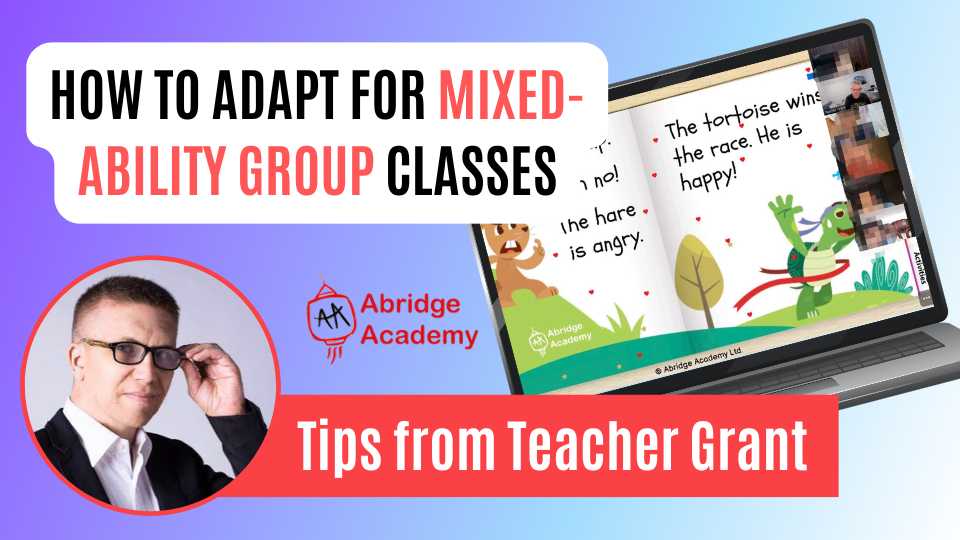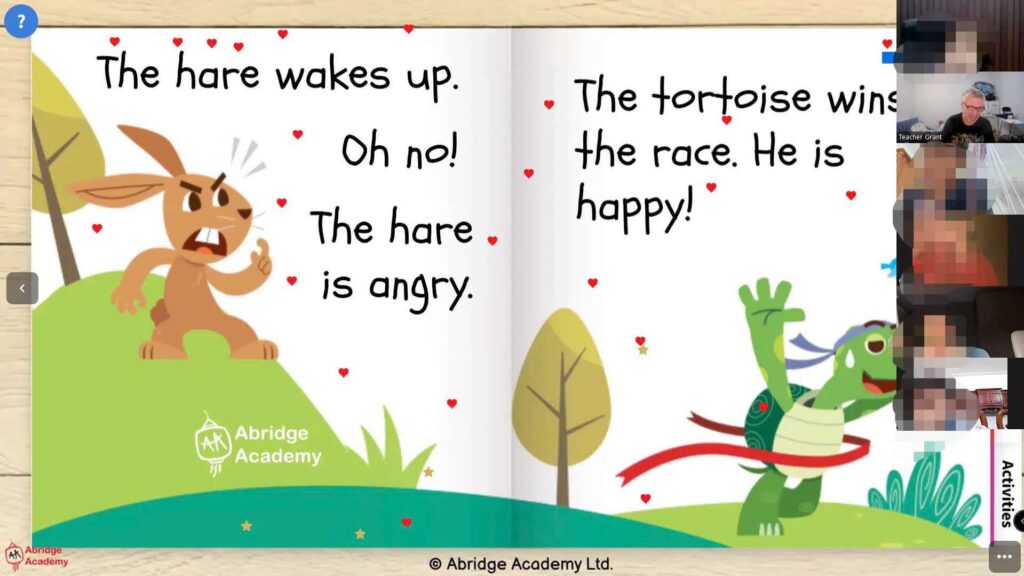Let’s give a warm welcome to Teacher Grant as he shares his top tips for adapting standard curriculum lessons, such as Abridge Academy’s interactive slides, to suit students of all ages, abilities, and interests! Grant has been teaching for over 15 years, including eight years teaching in schools across China, and currently lives in Vietnam where he offers online group classes for kids.
Recently, he put our new story-themed lessons to the test with a lively group of nine kids (ages 5-7). With such a mix of learners, he needed some simple yet effective strategies to keep everyone engaged—and now, he’s here to share them with you!

Before Class: Setting the Stage for Success
Advanced planning is the key to a smooth class experience! Before the class, Grant took time to carefully review his lesson plan and consider key adaptations. He recommends:
- Consider students’ interests and goals: Grant knew he wanted to focus on reading in this class, and selected the Abridge Academy’s The Hare and The Tortoise lesson as it would be a familiar story to better engage students.
- Select the appropriate level: As this lesson is available in multiple levels, he selected the pre-A1 level for beginners.
- Plan which sections to focus on: The Abridge Academy lessons are designed with multiple sections per lesson. For these students, Grant planned in advance to skip the grammar section, giving more time to focus on reading comprehension skills and discussion activities, as these were more of a priority for these learners.
- Prepare printed worksheets and craft materials: As Grant wanted to do the optional origami activity at the end of the lesson, he made sure to notify parents in advance to prepare some paper and scissors.
During Class: Adapting for Student Understanding
There’s only so much you can plan in advance! Grant emphasised the importance of implementing formative assessment activities to continually measure students’ understanding, and being flexible adjusting your teaching accordingly. For example:
- Using different questioning techniques: If students don’t understand a question, Grant gives them time to consider, then tries re-phrasing the question in a simpler way.
- Giving hints and scaffolding responses: When students struggle to phrase their answer, Grant highlights relevant keywords on the slides, uses gestures, circles useful images, etc to give them some clues.
- Adjusting interactivity style: The Abridge Academy lessons have many interactive activities built-in. However, some students struggle to use their teaching platform’s functionality, particularly on mobile devices or in group classes. Instead, Grant re-phrases his instructions, for example asking them to use Zoom’s annotation tools, emoji responses, or writing in the chat.
- Switching class roles: During the story part of this lesson, Grant found that several students struggled to read the sentences confidently. To help them engage in the class, he instead adjusted by reading the text himself, asking the student to repeat back and identify keywords.
During Class: Stretching Advanced Students
While it can be tempting to focus on the students struggling in class, it’s also important to challenge advanced learners to stretch their skills further. Here are some strategies Grant suggests:
- Ask in-depth questions: Encourage deeper thinking by asking more thought-provoking questions about the characters and story, requiring more extended responses.
- Foster student-led learning: Ask higher level students to create their own quiz questions about the story, which they can then use to create a simple quiz for their classmates.
- Offer more complex follow-up tasks: Grant often asks his more advanced students to come up with their own version of a story, perhaps putting a fun twist on it or re-phrasing in their own words, before presenting to the class. This stretches their creative writing and public speaking skills.

How do you Adapt Lessons for Mixed-Ability Classes?
Teaching diverse groups can be challenging, but with a little preparation and a willingness to adapt, it doesn’t have to be overwhelming! Teacher Grant’s experience shows that by thoughtfully selecting materials, planning around your students’ needs, and staying flexible during class, you can create an engaging and supportive learning environment for everyone. Whether it’s adjusting questions on the fly or offering creative challenges to advanced learners, these strategies can make all the difference.
Do you want to save time on lesson planning and focus on what matters most—your students? Check out the Abridge Academy curriculum, packed with pre-made lesson slides, worksheets, flashcards, and more. With these tools in your toolkit, you’ll have everything you need to deliver fun and effective ESL lessons tailored to your students’ needs.
